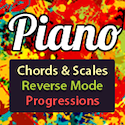As I took piano lessons for years growing up, I always dutifully completed the obligatory theory lesson that correlated with the repertoire pages for the week (even if I was scrambling right before the lesson to get it done!). However, after 10 years of lessons I still had no idea how to identify what key I was playing in. There was a complete disconnect between what I was playing and the theory work I was doing. This dichotomy is the primary reason why I rarely use theory books with my students, especially at the lower levels. Instead, we spend a great deal of time discussing the underlying theory of each piece of music and lots of repetition to memorize what each term and symbol means.
The Psalms Project we do each spring provides a wonderful opportunity for students to solidify their theory knowledge as they compose and learn to notate their compositions.
Even though we eventually input all of the compositions into Finale on the computer, I require students to notate everything by hand first as part of the learning process. It’s fun watching their “aha” moments as various concepts (like the fact that since the key signature includes an F# they don’t have to notate sharps on each F throughout the piece) click!















[…] translate to those aha moments when student look at their music. Natalie’s article, “Using Composition & Notation to Teach Music Theory” was a great reminder to keep this practice up … even after our April composition focus […]